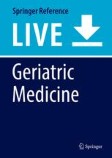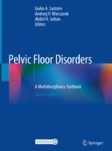Search
Search Results
-
Measuring Pelvic Organ Prolapse: An Evolution
Introduction and HypothesisAdvances in our understanding of pelvic organ prolapse (POP) have been made with the introduction of valid, reliable...
-
Obstructive Defecatory Symptoms with Pelvic Organ Prolapse
Pelvic organ prolapse may lead to a variety of clinical presentations including defecatory symptoms. Obstructed defecation is a subtype of defecatory...
-
Gynecologic and Urologic Problems in Older Women
Women 75 years or older are one of the most rapidly growing age groups. Thus, there is an increasing interest in the field of “geriatric gynecology.”...
-
Comparison of magnetic resonance defecography grading with POP-Q staging and Baden–Walker grading in the evaluation of female pelvic organ prolapse
PurposeThe physical examination and pelvic imaging with MRI are often used in the pre-operative evaluation of pelvic organ prolapse. The objective of...

-
Gynecologic and Urologic Problems in Older Women
Women 75 years or older are one of the most rapidly growing age groups. Thus, there is an increasing interest in the field of “geriatric gynecology.”...
-
The role of pelvic floor ultrasound correlated with pelvic organ prolapse quantification in the assessment of anterior and apical compartments of pelvic organ prolapse
BackgroundPelvic organ prolapse (POP) is a gynecological disease significantly associated with older age. A higher prevalence of women with...

-
Prevalence and associated factors of pelvic organ prolapse among women attending gynecologic clinic in referral hospitals of Amhara Regional State, Ethiopia
Introduction and hypothesisWhile pelvic organ prolapse is common in clinical observation, there is a lack of evidence regarding its actual proportion...
-
Pelvic organ prolapse surgical training program in Bangladesh and Nepal improves objective patient outcomes
Introduction and hypothesisThe DAK Foundation (Sydney) has facilitated pelvic organ prolapse (POP) repairs performed by local gynecologists for...

-
Validation and translation of the Hungarian version of the Australian Pelvic Floor Questionnaire (APFQ-H)
Introduction and hypothesisThe aims of the study were the translation, cultural adaptation, and validation of self-administered Australian Pelvic...
-
Clinical application of a fixed reference line in the ultrasound quantitative diagnosis of female pelvic organ prolapse
ObjectiveThis study explored using an improved ultrasound (US) for quantitative evaluation of the degree of pelvic organ prolapse(POP).
...
-
Current use of the pelvic organ prolapse quantification system in clinical practice among Korean obstetrician-gynecologists
BackgroundTo assess current use of the Pelvic Organ Prolapse Quantification (POP-Q) system in clinical practice among Korean...
-
Systematic review and meta-analysis of genetic association studies of pelvic organ prolapse
Introduction and hypothesisFamily and twin studies demonstrate that pelvic organ prolapse (POP) is heritable, but the genetic etiology is poorly...

-
Epidemiology and Etiology of Pelvic Organ Prolapse
Pelvic organ prolapse (POP) is a common condition with a prevalence increasing with age. The worldwide prevalence of POP has recently been reported...
-
Voiding Dysfunction After Female Pelvic Surgery
Pelvic surgery can result in voiding dysfunction. Neuropathic inadvertent iatrogenic trauma to the pelvic plexus occurs most often after radical...
-
Voiding Dysfunction After Female Pelvic Surgery
Pelvic surgery can result in voiding dysfunction. Neuropathic inadvertent iatrogenic trauma to the pelvic plexus occurs most often after radical...
-
Dynamic magnetic resonance imaging following native tissue vaginal reconstructive surgery; a prospective study
Introduction and hypothesisTo describe the impact of native tissue vaginal reconstruction on pelvic anatomy using dynamic magnetic resonance imaging.
...
-
Vaginal microflora following the use of a disposable home-use vaginal device and a commercially available ring pessary for pelvic organ prolapse management: a randomized controlled trial
PurposeTo investigate whether ProVate, a novel, disposable, self-inserted vaginal device for pelvic organ prolapse management, clinically affects the...

-
Do patients with central sensitivity syndromes have poor subjective outcomes despite anatomical cure from pelvic organ prolapse surgery?
IntroductionPelvic organ prolapse(POP) has an adverse impact on quality of life with lifetime risk of surgery varying from 11 to 20%. Conditions such...

-
Anatomical and functional outcomes after hysterectomy and bilateral sacrospinous ligament fixation for stage IV uterovaginal prolapse: a prospective case series
BackgroundAim of this study is to examine pelvic floor symptoms, anatomical results and patients’ satisfaction after sacrospinous vaginal fixation...

-
Risk factors for recurrence of pelvic organ prolapse after vaginal surgery among Ugandan women: a prospective cohort study
Introduction and hypothesisThis study was aimed at determining the recurrence rate and risk factors for the recurrence of pelvic organ prolapse...
